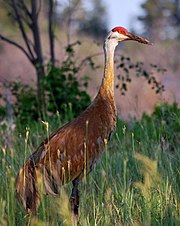| Common name | Scientific name and subspecies | Range | Size and ecology | IUCN status and estimated population |
|---|
| Sandhill crane  | Antigone canadensis
(Linnaeus, 1758)
- A. c. canadensis (Linnaeus, 1758) – northeast Siberia through Alaska and north Canada to Baffin Island
- A. c. tabida (Peters, JL, 1925) – south Canada and west, central United States
- A. c. pratensis (Meyer, FAA, 1794) – Georgia and Florida
- A. c. pulla (Aldrich, 1972) – Mississippi
- A. c. nesiotes (Bangs & Zappey, 1905) – Cuba and Isla de la Juventud (Isle of Pines)
| North America and extreme northeastern Siberia
 | Size:
Habitat:
Diet: | LC
|
|---|
| White-naped crane  | Antigone vipio
(Pallas, 1811) | Northeastern Mongolia, Northeastern China, and adjacent areas of Southeastern Russia
 | Size:
Habitat:
Diet: | VU
|
|---|
| Sarus crane  | Antigone antigone
(Linnaeus, 1758)
- A. a. antigone(Linnaeus, 1758) (Indian sarus crane)
- A. a. sharpiiBlanford, 1895 (Indochinese or Burmese sarus crane, Sharpe's crane, red-headed crane)
- A. a. gilliaeSchodde, 1988 (Australian sarus crane)
- A. a. luzonica Hachisuka, 1941 (Philippine sarus crane – extinct)
| Indian subcontinent, Southeast Asia, and Australia
 | Size:
Habitat:
Diet: | VU
|
|---|
| Brolga  | Antigone rubicunda
(Perry, 1810) | Northern and eastern Australia and New Guinea
 | Size:
Habitat:
Diet: | LC
|
|---|








